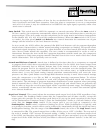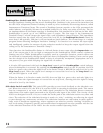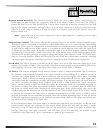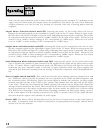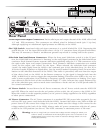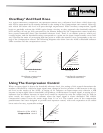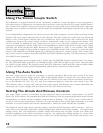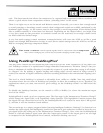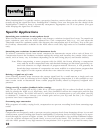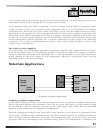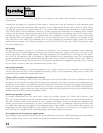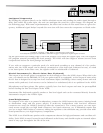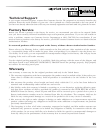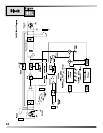
trols. This faster attack time allows the transients to by captured and compressed without overshoot and
allows a quick release from compression without “punching holes” in the sound.
There is no right way to set the Attack and Release controls. Generally, you want a slow enough attack
to avoid pumping or breathing sounds caused when background sounds are audibly modulated by the
dominant signal energy, yet the release must be fast enough to avoid suppression of the desired signal
after a sudden transient or a loud note has decayed. Depending on the desired effect, you might want
a very slow attack so that percussive or transient sounds are not restricted, but average volume levels
are held within the desired range.
A very fast attack setting (control maximum counterclockwise) will cause the 162SL to act like a peak
limiter even though RMS detection circuitry is used. Slower attack settings cause the 162SL to act like an
RMS or averaging detecting compressor/limiter.
Note:
Attack and Release controls operate together and in conjunction with the Compression
ratio control. Changing one control may necessitate changing another setting.
The Stop Level control sets the maximum peak output level of the 162SL irrespective of any other con-
trol. PeakStop consists of a sophisticated voltage-controlled Instantaneous Transient Clamp™ that pro-
duces a minimum of audible distortion. It rounds the corners of a peak rather than cutting it off sharply,
as “clippers” do. By making a signal's leading and trailing edges curved instead of sharp corners, it
reduces the amount of higher odd-order, offensive-sounding harmonics that conventional clipping caus-
es.
The level at which PeakStop is activated is adjustable from +4dBu to +24dBu. Note that small signal
excursions above the set value of PeakStop are possible, to allow the rounding to occur. Therefore, for
applications where you must not exceed a given ceiling, set the PeakStop control 1 to 2dB below the
ceiling.
To disable the PeakStop function, set the control to OFF (>+24dBu) (i.e: above the maximum output
level of the 162SL).
PeakStopPlus® is made up of two separate parts. The first stage is the Instantaneous Transient Clamp™
which clamps the signal with a soft logarithmic clamp function. This logarithmic function assures that
the signal will not exceed the level set by the PeakStopPlus® Level control by more than 2 dB typical-
ly, and that it will not introduce harsh artifacts.
The second stage is a unique program limiter featuring Intelligent Predictive Limiting™. Its function is to
monitor the input signal and intelligently predict the amount of gain reduction needed to keep the out-
put signal below the ceiling set by the Instantaneous Transient Clamp™. Note, since the PeakStopPlus®
limiter is a fail-safe limiter it must come after the Output gain control. If the output gain is set too high
as compared to the PeakStopPlus® Level control, continuous limiting can occur.
Using PeakStop
®
/PeakStopPlus
®
19



